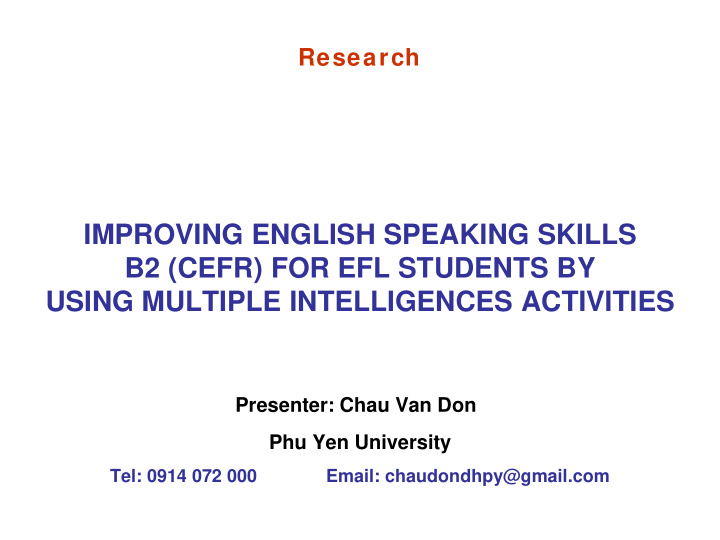



Research IMPROVING ENGLISH SPEAKING SKILLS B2 (CEFR) FOR EFL STUDENTS BY USING MULTIPLE INTELLIGENCES ACTIVITIES Presenter: Chau Van Don Phu Yen University Tel: 0914 072 000 Email: chaudondhpy@gmail.com
Intrapersonal intelligence Interpersonal intelligence Natural intelligence MULTIPL PLE E Musical/ Rhythmic INTEL ELLIGEN ENCES ES intelligence Logical-mathematical intelligence Verbal/ lingual intelligence Bodily/ Kinesthetic Visual-spatial intelligence intelligence 2
Questions of the Study Main question: What is the effectiveness of integrating MI classroom activities in developing EFL students’ English speaking skills?
Sub-questions: 1. What are the English speaking skills required for the 2 nd year English major students? 2. What is the actual performance of 2 nd year English major Ss in speaking skills? 3. What is the MI profile of the 2 nd year English major Ss? 4. Are Ss motivated when MI activities are integrated in the speaking training program? 5. What is the effect of integrating MI activities in developing speaking skills of the 2 nd year English major Ss?
Method of study The Experimental Design The one pre-post experimental design in which only the experimental group was used in the implementation process. This design was chosen because the study aims at developing speaking skills of a group of students. 03 English speaking pre-posttest and an English speaking training program integrated with MI classroom activities to develop students’ English speaking skills.
Scope of study Participants : 60 second year students at Phu Yen University Sampling Procedures 30 students in one experimental group who were trained to develop their speaking skills through an MI based instruction training program. Sample Size, Power, and Precision Participants were homogenous in terms of their academic level in English, and speaking skills.
Table 1. Results of the speaking skills checklist Speaking Skills Agreement Percentage 1. Talking about general topics 10 100% 2. Comparing pairs of pictures 8 80% 3. Expressing personal feelings about 10 100% the contents of a picture 4. Making quick decisions on how to 9 90% choose something 5. Persuading other people to agree 8 80% with your decision
Multiple Intelligences Inventory for EFL Young Adults An MI Inventory for Adults developed by Thomas Armstrong (2012) was administered to the experimental group of 2 nd year English major students. Through this inventory, the students gained some initially concepts on their preferred intelligences and learning styles. Simultaneously, the researcher could establish an intelligences profile of students. From this, the researcher designs the activities and tasks catering for the students’ preferred intelligences.
Table 2. Profile of the most dominant intelligences of the participants Standard Types of Intelligences Percentage Mean Deviation 1 Verbal-Linguistic Intelligences 82.35% 2.47 0.38 2 Logical-Mathematical Intelligence 35.29% 1.05 1.37 3 Interpersonal Intelligence 70.59% 2.12 0.62 4 Intrapersonal Intelligence 70.59% 2.12 0.62 5 Bodily/kinesthetic Intelligence 44.12% 1.32 1.19 6 Visual/Spatial Intelligence 94.12% 2.82 0.13 7 Musical/Rhythmic Intelligences 23.53% 0.70 1.62 8 Naturalistic Intelligences 20.59% 0.67 1.68
The Speaking Pre-Posttests a. Aim of the tests 03 English speaking tests were used to develop the 05 English speaking skills of the students as mentioned before. These parts represented the core of speaking development program for the first year students at Phu Yen University (Based on the Common European Framework of References for Language, Level B2, CEFR). Designing the tests was based on reviewing appropriate viewpoints of EFL specialists as well as on related literature.
Results Statistical Procedures: - Statistical Package for Social Sciences (SPSS, version 23.0) was used in the treatment of the results of the study. - T-test formula was employed in analyzing students' scores on the speaking skills test.
Results Comparison of the Test Scores of the English Speaking Test 1, 2 & 3 between the Experimental Group and the Controlled Group Number of students Number of students in experimental in controlled group group The (N=30) P value of (N= 30) Effect t-test Size Mean Standard Mean Standard score deviation score deviation English Speaking 0.86909 0.01943 6.1000 0.80301 6.0667 0.90719 9 1 Test 1 English Speaking 7.1000 0.75886 6.7000 0.79438 0.043397 0.249328 Test 2 English Speaking 0.00093 0.39382 0.72734 7.4000 0.71197 6.7833 0 0 Test 3
Conclusion Integrating MI classroom activities is an effective way to develop students’ English speaking skills. Application of MIT into EFL classroom contexts has provided many opportunities for both language teachers and students in: - Transitioning from the traditional methods of teaching, learning and assessing towards a more humanitarian way of all-round training; - Evaluating students’ learning abilities and outcomes according to their preferential learning styles and intelligences.
Implications - MIT enables EFL teacher to promote their students’ English speaking skills; - Through MI classroom activities, students will be able to demonstrate and share their strengths; - The application of MI classroom activities and assessment creates fundamental and comprehensive renovation of education and training - In the light of MIT, EFL teachers can help their students solve many problems in their learning activities and create relevant language products which are designed and presented through students’ diversity of intelligences and learning preferences.
REFERENCES 1. Gardner, H (1983), Frames of Mind: The Theory of Multiple Intelligences , Basic Books, A Member of the Perseus Books Group, USA. 2. Salem, A. M. S (2013). The Impact of Multiple Intelligences- Based Instruction on Developing Speaking Skills of the Pre- Service Teachers of English . ISSN 1916-4742 (Print) ISSN 1916-4750 (Online). Canadian Center of Science and Education. 3. Sayed, M. M. (2008). Multiple Ways to be Smart: Gardner's Theory of Multiple Intelligences and its Educational English Teaching and Oral Communication . Website: http://eric.ed.gov/?id=ED502634. (And 15 other references)
“It’s not how smart you are that matters, What really counts is how you are smart.” Howard Gardner THANK YOU
Recommend
More recommend